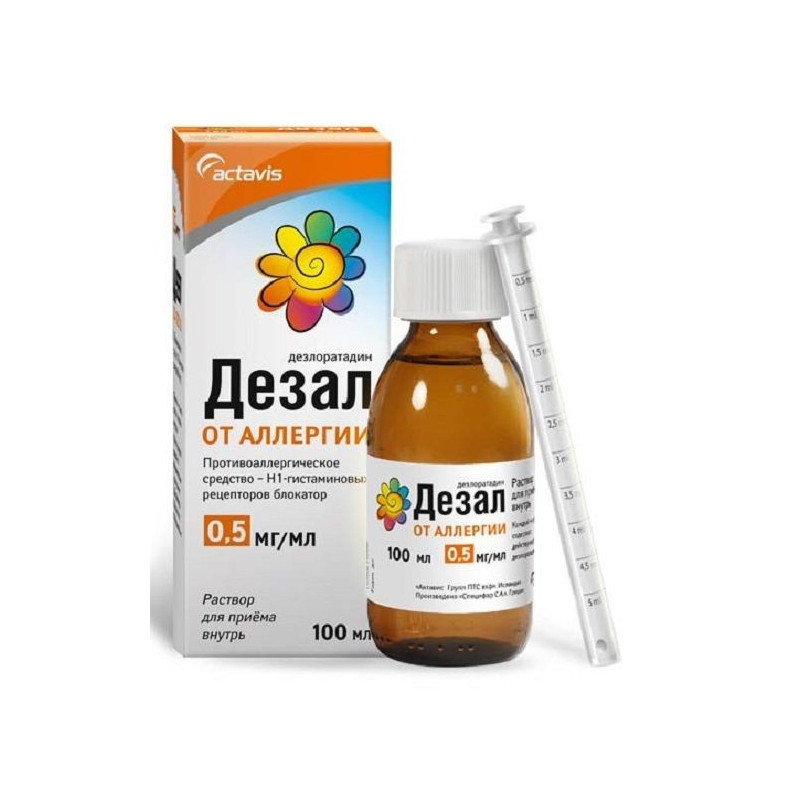



 All payments are encrypted via SSL
All payments are encrypted via SSL
 Full Refund if you haven't received your order
Full Refund if you haven't received your order
To relieve or eliminate symptoms:
- allergic rhinitis (sneezing, nasal congestion, rhinorrhea, itching in the nose, itching of the sky, itching and redness of the eyes, watery eyes);
- urticaria (pruritus, rash).
Is ingested, regardless of the meal.
Children aged 1 to 5 years - 2.5 ml solution (1.25 mg) 1 time / day.
Children aged 6 to 11 years - 5 ml of solution (2.5 mg) 1 time / day.
Adults and teenagers (12 years and older) - 10 ml solution (5 mg) 1 time / day.
In children aged 2 to 11 years with the use of Desloratadine, the frequency of side effects was the same as with placebo.
The following side effects were observed in children under 2 years of age with the use of desloratadine, the frequency of which was slightly higher than with placebo: diarrhea (3.7%), increased body temperature (2.3%), insomnia (2.3%).
The following side effects were observed in adults and adolescents aged 12 years and older with the use of desloratadine, the frequency of which was slightly higher than with placebo: fatigue (1.2%), dry mouth (0.8%), headache (0.6%).
When using the drug in adults and adolescents in the recommended dose of 5 mg / day, the frequency of drowsiness is not higher than with placebo.
Very rarely in post-marketing surveillance. The following adverse reactions were noted.
Mental disorders: hallucinations.
From the side of the central nervous system: dizziness, drowsiness, insomnia, psychomotor hyperactivity.
Since the cardiovascular system: tachycardia, palpitations.
From the digestive system: abdominal pain, nausea, vomiting, dyspepsia, diarrhea.
Liver and biliary tract: increased activity of liver enzymes, increasing the concentration of bilirubin, hepatitis.
From the musculoskeletal system: myalgia.
Allergic reactions: anaphylaxis, angioedema, pruritus, rash, urticaria.
- hypersensitivity to the active or any excipient of the drug;
- pregnancy;
- lactation period (breastfeeding);
- children's age up to 1 year (efficacy and safety have not been established);
- hereditary diseases - fructose intolerance, impaired glucose / galactose absorption or deficiency of sucrase / isomaltase in the body (due to the presence of sorbitol in the preparation).
WITH caution should use the drug for severe renal failure.
Use during pregnancy and lactation
The purpose of the drug during pregnancy is contraindicated due to the lack of clinical data on the safety of its use in this period.
Desloratadine is excreted in breast milk, so its use during breastfeeding is contraindicated.
Application for violations of kidney function
With caution should use the drug in severe renal failure.
It is contraindicated in children under the age of 12 years, because efficacy and safety not established.
The efficacy and safety of Desal in children under the age of 1 year has not been established.
The differential diagnosis between allergic rhinitis and rhinitis of a different origin in children under 2 years of age presents certain difficulties. When conducting a differential diagnosis should pay attention to the presence or absence of foci of infection or structural abnormalities of the upper respiratory tract, to conduct a thorough history, examination, as well as appropriate laboratory tests and skin tests.
Approximately 6% of adults and children aged 2 to 11 years old have a low metabolism of desloratadine, desloratadine in this group of patients is eliminated more slowly. The safety profile of desloratadine in children aged 2 to 11 years with a low metabolic rate is similar to that in children with normal metabolism of desloratadine. The effect of desloratadine on children under 2 years of age with a low metabolic rate has not been studied.
In the case of pronounced impaired renal function, Desal should be taken with caution.
Impact on the ability to drive vehicles and mechanisms
AT Investigations of the effect of desloratadine on the ability to drive motor transport did not show any disruption in concentration.However, it should be borne in mind that it is very rare for some patients to develop drowsiness, in this case care should be taken when driving and working with mechanisms.
Symptoms: Reception in a dose exceeding recommended in 9 times (45 mg), did not lead to the appearance of any clinically significant symptoms. Perhaps the development of drowsiness.
Treatment: necessary gastric lavage, taking activated charcoal; if necessary, symptomatic therapy. Desloratadine is not excreted by hemodialysis, the effectiveness of peritoneal dialysis has not been established.
In case of accidental ingestion of a large amount of the drug, the patient should immediately consult a doctor.
No clinically significant interaction with other drugs was revealed (including with Ketoconazole and erythromycin).
Desloratadine does not enhance the effect of ethanol on the central nervous system.
Pharmacy sales terms
The drug is approved for use as a means of OTC.
Terms and conditions of storage
The drug should be stored out of the reach of children at a temperature not higher than 25 ° C.
